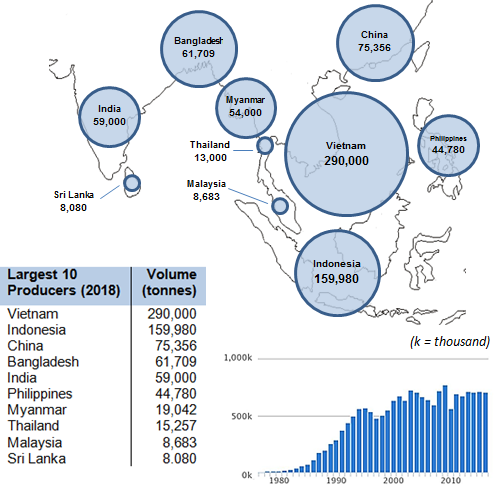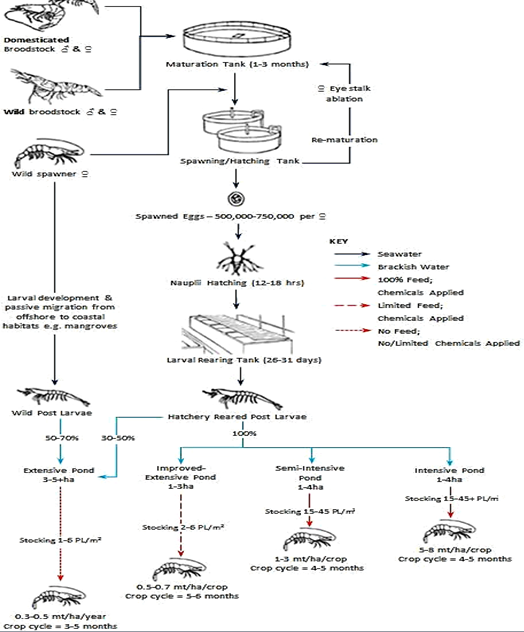Tiger Prawn
Penaeus monodon
Sources, Quantities and Cultivation Methods
Sources and Quantities
The terms shrimp and prawn are often used interchangeably however in this profile the term prawn is used. The two warm water prawns that dominate world markets are farmed penaeids (i.e. prawn species from the Penaeidae family); namely the Asian, black or giant tiger prawn (Penaeus monodon) and the white leg prawn (Litopenaeus vannamei, known as “vannamei”). Monodon inhabits tropical marine coasts of Australia, South and SE Asia, and East Africa1.
In 2018 warm water prawns are cultured in over 40 countries, and the industry is an important source of jobs worldwide. Asia is by far the largest prawn farming region with over 80% of the production, followed by the Americas Latin America , which represents around 17%. Farmed warm water prawns are the most valuable of all aquaculture sectors, worth over US$30 billion annually2.
Monodon is cultured across the Asia-Pacific region as the map illustrates. Monodon makes up ~15% of global production of farmed warm water prawns; much lower than vannamei which accounts for ~75%. The remaining ~10% is made up of minor species3. Globally monodon farming was worth some US$6.3 billion from a 2018 total production of some 750,604 tonnes2.
Europe is a major market for warm water prawns, with Spain, France, Italy, the UK, Belgium, Germany, and the Netherlands accounting for 90% (€3.3 billion) of the total frozen prawn import value in 20144, 5.

Domestic Market Information
Our domestic seafood market is complex mix of products from wild caught and farmed species, including warm water prawns, which are the number one shellfish species in Great British retail (i.e. in England, Scotland and Wales). Although consumers often see all types of prawns as the same, over the past 20 years the consumption of farmed warm water prawns has significantly increased.
To discover more about the highly dynamic and ever-changing seafood market landscape, you can explore our user friendly and interactive Trade and Tariff in Tableau (T4) online tool, whilst a visit to our dedicated Insight and Research pages will provide you with access to a wealth of market information – from figures to factsheets – on aspects including:
- Market supply – HM Revenue and Customs (HMRC) data used to reveal what species and products are imported from, and exported to, the UK
- Foodservice – data from the foodservice industry in the UK used to highlight the latest trends on seafood eaten out of home
- Retail – data from independent and multiple retailers in the UK used to reveal the latest insights on seafood eaten at home
Production Method
Modern warm water prawn farming began in the 1960s, became a significant industry in the 1990s, and has grown rapidly ever since. Farms are generally located on or near the coast, and use brackish water in their ponds.
Wild monodon spend their post-larval and juvenile stages in coastal estuaries, lagoons or mangrove areas. They migrate to deeper water when they become adolescent and move to spawning grounds as adults. Females produce as many as 500,000-750,000 eggs. Larval stages remain planktonic while tidal currents carry them towards the shore. At this point the young monodon post-larvae become benthic, feeding on detritus, worms and small crustaceans. Traditional pond culture of warm water prawns involved trapping and holding wild post-larvae occurring naturally in coastal zones and this practice continues6.
During the 1970s breeding techniques were developed for some prawn species enabling hatcheries to supply farmers with post-larvae. However, this is generally not the case for monodon, its farming still relies almost entirely on wild stocks7; either by recruiting passively collected wild seed for more traditional production, or the capture of wild broodstock for producing hatchery-reared post-larvae. Wild broodstock are induced to spawn through unilateral eyestalk ablation (removal of one eye) which stimulates the endocrine system and results in ovarian development. However, the mechanism is not fully understood and research continues to find alternative methods.
Although several companies and institutions are developing, or have already developed, fully domesticated monodon stocks8, 9, 10, progress in domesticating monodon (therefore eliminating the industries dependence on wild stocks) lags behind that of vannamei, and broodstock and post-larvae supplies from such sources are still low. Advances in captive breeding on a commercial scale will eventually reduce and eliminate the need for wild collection, and enable supply of disease-free (Specific Pathogen Free or SPF) and disease resistant (Specific Pathogen Resistant or SPR) post-larvae11.
Quality and health status of post-larvae is extremely important as farmed prawns can suffer from several diseases which can cause massive losses, both in production and value. This is perhaps best illustrated by the recent outbreak of Early Mortality Syndrome (EMS) (also knowns as Acute Hepatopancreatic Necrosis Syndrome or AHPNS) and the subsequent slump in global production between 2012 and 201312.
Shrimp farms are typically characterised by their intensity level i.e. production per unit area. There are three basic practices: extensive, semi-intensive and intensive pond culture, which represent low, medium and high stocking densities respectively.
- Extensive and Improved-extensive cultivation is carried out using wild post-larvae either entering the ponds on the tide or purchased from collectors, or cultured post-larvae from hatcheries. Extensive ponds are large and fertilised with organic and inorganic fertilisers with a daily water exchange of 10-15%. Stocking density is low and the prawns feed on natural foods (enhanced by pond fertilisation) which are supplemented by artificial diets. Prawn yields are relatively low but polyculture is often practiced and the ‘side-species’ (e.g. mudcrab13) can make major contributions to farmer incomes.
- Semi-intensive cultivation ponds are stocked at moderate densities with hatchery produced post-larvae. Water exchange is regularly carried out by pumping and aerators are used to maintain dissolved oxygen levels. Supplementary feed is provided by the farmer.
- Intensive cultivation ponds are generally small and they are stocked at higher densities. There is vigorous aeration, and regular feeding. Water exchange is limited, especially where there is risk of disease. When such closed systems are used careful monitoring and management of water quality is required. High production harvest volumes can be achieved.

Many monodon farmers have switched to cultivating vannamei14 although vannamei often commands a lower market price. Advantages of switching can be larger yields produced more quickly and in less saline water, as well as better disease resistance.
References
- FAO
- FAO FishstatJ
- GAA GOAL
- CBI
- CBI
- FAO
- Benzie, J.A.H., 2009. Use and Exchange of Genetic Resources of Penaeid Shrimps for Food and Aquaculture. Reviews in Aquaculture Special Issue on Use and Exchange of Genetic Resources of Cultured Aquatic Organisms, Vol. 1, Issue 3-4
- Unima
- CSIRO
- SGIC
- Kona Bay
- FAO
- FAO
- FAO
- Cocker, L.M., 2014. Initial draft 'Farmed Marine Shrimp in Vietnam' for Seafood Watch